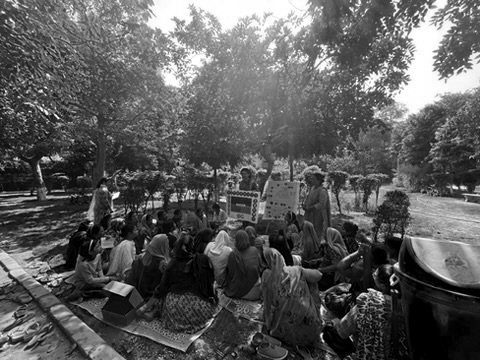
Charting The Margins —
Co-creating a People’s Place Inventory

Charting the Margins is a community-based practice that assesses and monitors public amenities, which comprise Delhi’s diverse public spaces with distinct women groups. Okhla and Okhla Phase II, located in Delhi's southeast district, are the pilot sites for this project.
In our previous project, we worked with female street vendors in Raghubir Nagar.
While the focus of that engagement was to understand women’s mobility patterns impacted by rampant urbanisation, this project takes a step further to understand how governance and planning challenges shape issues of accessibility for women with unique circumstances in the urban setting.
Delhi’s rapid urbanisation has been pushing the marginalised towards even more precarity. Recognising that plans dictating the future of urban environments are devoid of people and their complexities, we have intended to centre their issues on governance responsibilities and planning priorities. Cognisant of the social realities of class, religion, and gender, we wanted to foreground the voices of those under-prioritised in this city's governance and planning architecture. As an outcome, the initiative aims to co-create a Peoples’ Place Inventory across three scales: the individual, the neighbourhood, and the city, by zooming into everyday vulnerabilities and barriers to accessibility, which make travel, care responsibilities, work and leisure arduous for most women.
Thus, our project highlights community—and context-specific issues based on women’s perceptions of the quality of their public places in partnership with ASTHA (a local NGO based in Okhla).
Facilitated by Saleha Sapra and Anupriya Aggarwal, this socially engaged art practice is supported by Khoj Studios in New Delhi.
This website is best viewed on a desktop in full screen. Press 'F' for full screen mode. Press 'Z' to fit the website to the width of your screen.
The People’s Place Inventory (PPI) framework is applicable in other contexts in a way that is readable and understandable to mostly all stakeholders, which is why we are working to extend it to the whole of Delhi (presently lacking) to keep a citizen-driven account of the city’s public spaces. This exercise aims to showcase grassroots work and the complexity of urban issues and, importantly, encourages associated action.
On the right: A place inventory developed post our Aao, Jagah Banaye! engagment with the female informal workers in Raghubir Nagrar, New Delhi. Contact us at connect@citysabha.org to learn more about working together, contributing to the place inventory and resource sharing.
Download a copy of the Public Space Inventory matrix to use in the context of your work and stakeholders. Copyright of City Sabha 2023, please credit in use.

